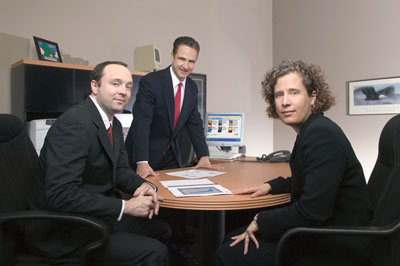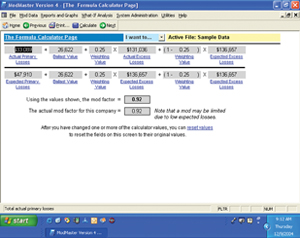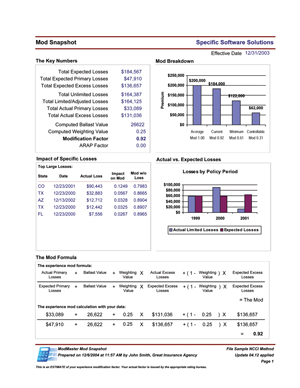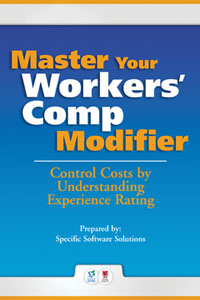
TECHNOLOGY
ACTUARIALLY DETERMINED
Software suite lets agents compete with the mega-brokers
By Michael J. Moody, MBA, ARM
 |
| From left: Al Rhodes, ACAS, MAAA, President and Senior Actuary, Specific Software Solutions and SIGMA Actuarial Consulting Group, Inc.; Timothy L. Coomer, Chief Executive Officer; and L. Michelle Bradley, ACAS, MAAA, ARM, Consulting Actuary. |
Necessary resources
That’s the idea behind Specific Software Solutions and its sister company, SIGMA Actuarial Consulting Group (SSS/SIGMA). While their value-added services can run the gamut from loss control and loss prevention services to claims management services and everything in between, one service offering that is frequently purchased is actuarial and loss forecasting. Al Rhodes, president and senior actuary for SSS/SIGMA, says there’s a growing interest by mid-sized brokers in offering value-added services to their customers and prospects. Actuarial services are typically among the first required, especially when investigating any alternative market approach. “Usually the first step when someone is talking about a captive, for example,” Rhodes notes, “is determining future losses. This will drive whether a company will go with a captive or a more traditional approach.”
Rhodes and Chief Executive Officer Tim Coomer co-founded the company to provide analytical tools and independent actuarial services for a variety of governmental entities, associations, self-insureds and brokers throughout the country. Both Rhodes and Coomer worked for Corroon & Black’s Advanced Risk Management Services unit and based their approach to business on that model. Coomer states that “we consider ourselves as in-house resources to our clients,” and SSS/SIGMA tries to provide a flexible approach tailored to their clients’ needs. As a result, the company has essentially been built on two complementary business applications.
 |
One offering is a suite of analytical tools that can assist with a variety of risk management tasks. |
 |
Software suite
One offering is a suite of analytical tools that can assist with a variety of risk management tasks. The analytical tools encompass five separate areas. Two of the software applications are Web-based tools. QuickMod provides an instant workers compensation experience modification analysis. It allows a user to enter summary values from an experience mod worksheet, and it then generates several critical analyses in a matter of minutes. Among the reports provided are a mod formula, a minimum and controllable mod analysis, as well as a specific loss and aggregate loss sensitivity analysis.
The other Web-based tool, Quick Loss Pick, provides the user with a prompt loss determination for a user’s workers compensation coverage. The program uses historical incurred loss data, and payroll information to estimate a loss projection in minutes.
The remaining three tools are PC-based software products, which provide more in-depth analyses than the Web-based packages. ModMaster is a comprehensive software package that is designed to compute, analyze and present a user’s workers compensation modification factor. In addition to the mod, the software can generate a number of other insightful analyses, including such things as Mod Snapshot that has five mini reports on one page, and Ratio Analysis, which provides detailed information regarding the actual vs. expected losses.
The second program, Loss Forecaster, provides actuarially sound loss projections based on the latest trend and loss development research. Reports that are generated can be used for a variety of applications such as underwriting submissions or client proposals.
The final product, NPVision is the most comprehensive offering and was developed to compare various types of loss financing programs. The software quickly compares a variety of insurance programs including guaranteed cost, incurred loss retro, paid loss retro, and large deductible programs, on a net present value basis.
Coomer notes that all of the mega-brokers use one or more of the software products as do over 80% of the top 100 brokers. Ease of use and flexibility of application have been the reason for the growth in software usage. Most of the software packages make extensive use of video training as part of the package, and, Coomer says, SSS/SIGMA modifies the training to meet the needs of the client.
Actuarial services
In addition to the software products noted above, the firm also provides independent actuarial services to a wide variety of clients. They have expertise in a broad range of coverage areas including workers compensation, automobile liability, general liability, and product liability. Included in the types of analyses that are provided are:
• Actuarial Reserve Analyses—These analyses provide a professional opinion regarding the loss reserves required for unpaid claims incurred as of a specific date. This type of analysis is usually required to meet regulatory or financial reporting criteria as part of an external audit in connection with a self-insured trust, captive insurance, or loss-sensitive cash flow plan.
• Loss Projection and Loss Probability Study—These studies include actuarial estimates of ultimate loss costs for completed policy periods, as well as projected losses for current and future periods. These studies help to define appropriate levels of risk retention and policy limits that can assist in market negotiations.
• Cash Flow Analyses—These analyses assist in determining the timing of the payout of required reserves. A typical study would provide a present value analysis that indicates the current value of expected future payments at one or more designated discount rates.
The company can also provide independent actuarial analysis for special studies such as the effectiveness of loss control programs; due diligence evaluations regarding mergers, acquisitions and divestitures; self-insured and/or captive feasibility studies; and other unique risk financing considerations.
SSS/SIGMA provides the results from their actuarial services in a flexible format. Coomer says “some agents feel better saying that they have a good, established relationship with an independent actuary.” In those situations, SSS/SIGMA will issue the report under their own name. However, if the agent wants to have the service appear that it is coming from him or her, SSS/SIGMA will issue the report in the name of the agent. This “private labeling” option can be modified to meet the needs of the individual groups involved.
Future direction
 |
| One of the books provided by SSS/SIGMA to help clients determine ways to control workers comp costs. |
SSS/SIGMA believes that there are several trends that will continue to grow in the coming years. Each offers brokers unique opportunities to showcase their value-added approach to customers and prospects. One issue that provides brokers with an immediate window of opportunity is the recent enactment of the Sarbanes-Oxley Act of 2002 (SOX). In the past, a firm’s outside auditors typically provided their clients with in-house actuarial services. However, SOX prohibits auditors from these types of arrangements. Thus, organizations that use auditor-related actuaries are now looking for replacements.
“Even though the legislation was geared only to public companies,” Coomer says, “there is an overall sense in the industry that there ought to be independence with regard to your actuary.” As a result, the SOX requirement for an independent actuary can be “a great door opener.”
Another potential growth opportunity is the result of an increased emphasis on controlling employee benefit costs. This increased interest, along with the recent Department of Labor ExPro approval process, will now allow captive owners to add employee benefits to their captive. Rhodes notes that captives “are moving in that direction.” He says there are “lots of discussions going on about this now,” and it should provide yet another value-added topic to discuss with prospects and customers.
In addition to the above noted areas, SSS/SIGMA is fortunate to have an actuary, Michelle Bradley, who has experience in enterprise risk management (ERM). While employed at Willis, Bradley worked on a number of ERM programs and has done similar projects since joining SIGMA. Bradley observes that ERM “was popular three or four years ago, but then went away.” She says, “However, over the past two years interest is again increasing. Now, it is certainly an item of importance for a lot of companies. Corporate governance has become a big deal.” In addition, Bradley thinks that the recent publication of the COSO ERM Framework will advance the movement to conformity. In the long run, she believes that the COSO ERM Framework will provide the information that will help corporations implement ERM programs. (More on the COSO ERM Framework is available in the “Enterprise Risk Management” column on page 42 of this issue.)
Conclusion
As one looks over the current brokerage landscape, it is obvious that some agents and brokers are poised for significant growth, most of which will come at the expense of the mega-brokers. This movement will, however, be limited to those brokers who can provide the array of value-added services needed by larger customers. Comprehensive analytical tools and independent actuarial services such as those offered by SSS/SIGMA can put the mid-sized broker on a more level playing field with the mega-brokers. As Coomer puts it, “these are the brokers who are moving beyond selling.” *
For more information:
SSS/SIGMA
Web site: www.specificsoftware.com